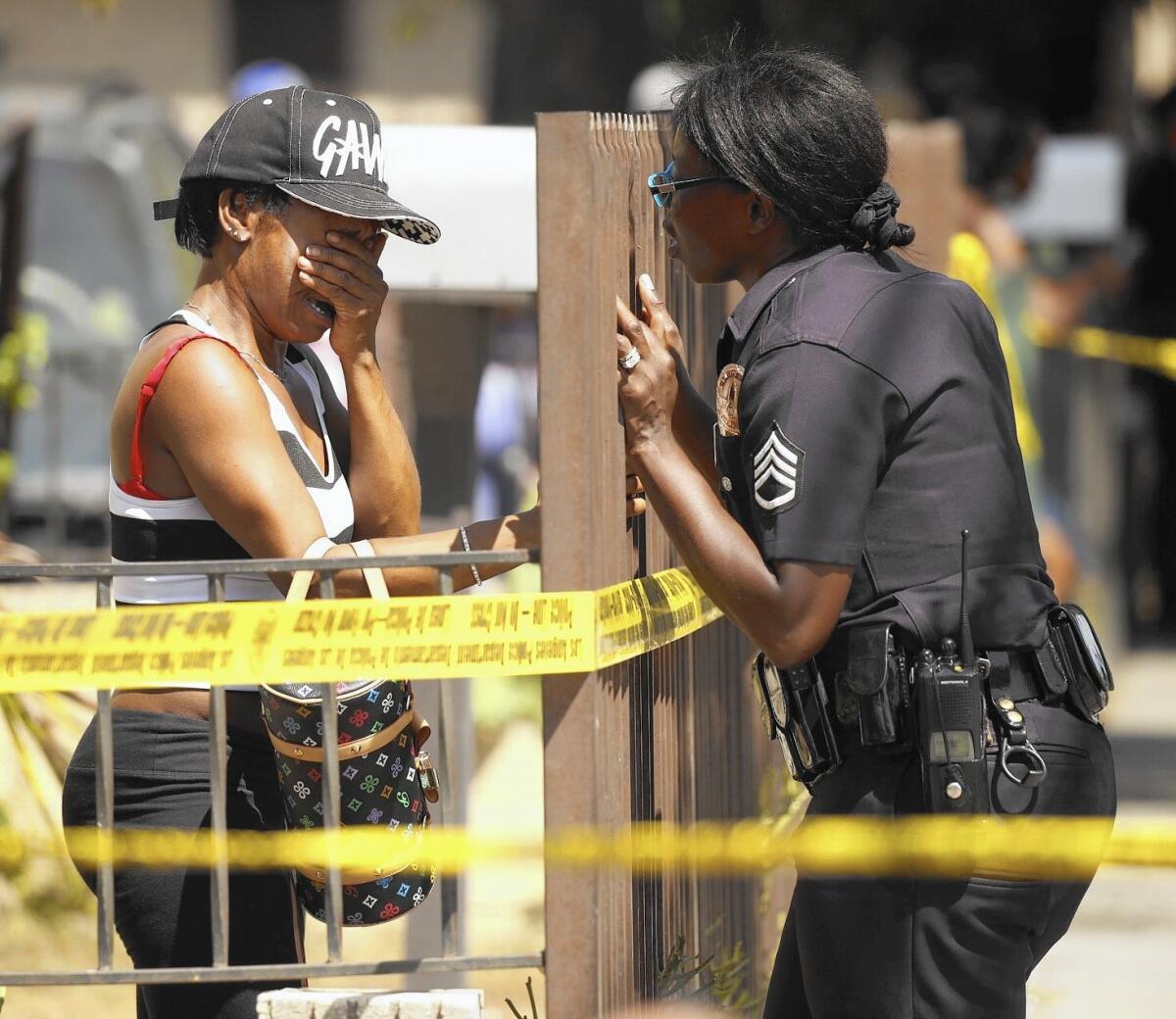Column: ‘Cyber banging’ drives new generation of gang violence

- Share via
Crime in the city continues to rise and gang violence in South Los Angeles accounts for much of that.
The LAPD has been trying to settle things down, but flooding the area with officers hasn’t worked. Neither has relying on veteran gang members to manage rivalries. Or pleading with residents to report what they know or see.
Until recently, those tactics helped drive crime down to a 20-year low. But gangbangers have become bolder, and the violence is less predictable. Residents fear gangs more than they trust the police.
The surge in shootings over the last few months reveals how little we know about what drives crime — and suggests the limits of our holy grail, community policing.
Half of the city’s August homicides occurred in South Los Angeles, and 70% of those are believed to be gang-related. For many residents, that feels like a return to the bad old days.
Now the whole conflict is happening on social media. And all of us -- interventionists, police, the community -- are in over our heads on that.
— Councilman Marqueece Harris-Dawson
Mayor Eric Garcetti insists Los Angeles’ crime-fighting plan is sound. He places a lot of stock in gang intervention teams:
“These are folks who can actually go to the shot callers and say: ‘Hey, can we put gang truces out there, can we look at what’s happening and make sure that whatever retribution is going back and forth, we stop it in its tracks?’ ” Garcetti said at a news conference last month.
Really Mr. Mayor? That’s the conversation you think is happening in the streets?
That’s not how it works. That’s not how any of this works.
::
If only the bargain were that easy and the process that civil.
These days, even gang intervention workers have targets on their backs.
“These youngsters are not listening … anymore. They have their own agenda,” an LAPD detective told me.
Some view interventionists as sellouts who are aligned with law enforcement. Gang counselors are paid by the city, but their histories and rap sheets confer a sense of credibility, giving them what’s known in the streets as a “license to operate.”
In some ways, the program has been hobbled by its success.
After summer intervention programs led to dramatic drops in crimes, teams were stripped from some neighborhoods to staff others; new workers have been hired but not yet trained.
A bigger problem, however, is that gangs have evolved in ways that make them harder to rein in — and the aging corps of gang workers hasn’t kept pace.
“Interventionists have been extraordinarily helpful,” said Deputy Chief Bob Green, who headed the LAPD’s South Bureau for 10 years. “Some of these guys had lived in the same neighborhood for 20 or 30 years — except for the time they spent in prison. They gave us the ability to get into places not impacted by community leaders but influenced by the guys in the streets.”
But things have changed since those “OGs” were running things.
Gangs are less hierarchical and more impulsive. They’re not as likely to feud over turf or look to “shot callers” for orders. And the spats that lead to shootings more often are linked to insults exchanged on social media than to the wrong color shoes or stare-downs at the park.
“The millennials are having an impact on crime, just as they are in other walks of life: politics, business, media, art,” Councilman Marqueece Harris-Dawson said. “Their sense of alliance [and] response to authority is different.… Something generational is happening, and we haven’t quite caught on.”
When Harris-Dawson, 45, was growing up in the South Los Angeles district he now represents, someone died in a gang-related crime almost every day. Now crime is near historic lows, despite the recent rise. But the flurry of shootings— 19 last weekend, when five people died — has residents on edge.
“It’s a spike, and it’s fast, and there’s no rhyme or reason,” Harris-Dawson said. “Before, we knew people were fighting over space to sell crack.… Or they were at a party or a park and somebody got mad, left and came back with a gun.”
Many of the people who were shot this summer seem like inexplicable targets, neither robbery victims nor gang-involved. “Somebody just drives to where the person is, walks up, shoots them, gets back in the car and drives off,” Harris-Dawson said.
“We’re used to people beefing in public,” he said. “Now the whole conflict is happening on social media. And all of us — interventionists, police, the community — are in over our heads on that.”
::
LAPD Deputy Chief Bill Scott doesn’t disagree.
“We’re dealing with a different generation and we’re going to have to evolve,” said Scott, who commands the five divisions in South Los Angeles.
“By the time police learn about something happening on social media, it’s already after the fact,” he said. “We’re the last ones to know.”
His team has coined a term for the violence: “cyber banging.” And they’re trying to recruit new intervention crews of streetwise, online sleuths who can scour posts and decipher signs of trouble.
Crime-fighting tactics aside, the department has some bridge-building to do.
Fear is threatening to steamroll the progress that had been made. At community meetings, vigils and rallies against violence, residents say they feel under siege by gangs and unprotected by police — even though the actual number of violent crimes hasn’t budged that much.
That may be a function of social media too.
“Even people that don’t watch the TV news or read the paper are getting exposed to levels of violence they’re not accustomed to,” Scott said. Their cellphones deliver photos of dead bodies, viral threats and rumors of killing rampages.
So residents pledge in public to take back the streets, yet witnesses are too frightened to talk privately to the police.
I can’t say I blame them.
After a mentally disabled young man was shot at a carwash this summer because he was wearing red shoes, his mother fingered the suspects and held a news conference. A man considered a local hero — even by some young gang members — denounced violence.
Not long afterward, his car was riddled with bullets as he drove down a neighborhood street in the middle of the day. It took three weeks for his family to raise enough money to bury him.
Twitter: @SandyBanksLAT
Hoy: Léa esta historia en español
More to Read
Sign up for Essential California
The most important California stories and recommendations in your inbox every morning.
You may occasionally receive promotional content from the Los Angeles Times.











